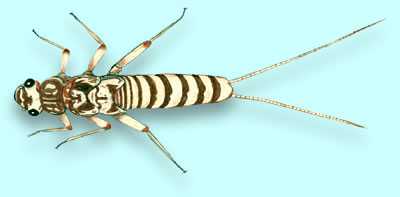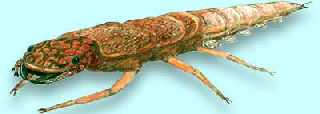
Stoneflies, order Plecoptera, are distinguished by two long thin tails projecting from the rear of the abdomen.
The body is somewhat flattened, and there are two claws that extend from the three pairs of segmented legs.
Stoneflies are considered crawlers and crawl around looking for food. They are not tolerant of water pollution.
|

Mayflies, order Ephemeroptera, are known for their short adult lifespan, often only a few hours.
The larvae have elongated bodies that are slightly flattened. The wingpads and three pairs of legs are on the thorax.
Each leg has a claw at the end for grasping material to move around.
Three long tails usually occur at the end of the body. Mayflies do not tolerate pollution well.
|

Damselflies, order Odonata, have an elongate body and most noticeably have three long gills projecting from the abdomen.
The head is wider than the thorax and the abdomen.
Damselflies are considered facultative, in that they prefer good water quality but are somewhat tolerant of impaired water quality.
|

Dobsonflies, order Megaloptera, are a small group whose larvae have flattened, elongated bodies.
They have prominent chewing mouth parts and three pairs of segmented legs.
At the end of the abdomen there is a pair of pro-legs (unsegmented appendages) with two claws on each.
The adults are distinguished by a pair of long wings that have many veins.
Dobsonflies are considered beneficial to the water body which they inhabit as they increase diversity.
They thrive in clean to moderately clean water.
|

Dragonflies, order Odonata, are similar to damselflies, but the body of the larvae tends to be long and stout or oval and flattened.
Dragonflies do not have gills on the abdomen. Three short, stiff, pointed structures occur at the end of the abdomen.
Like damselflies, dragonflies are predators and as adults move fast to capture prey.
Also like damselflies, they tolerate some level of impaired water quality.
|

Caddisflies, order Trichoptera, is the largest order of entirely aquatic insects.
Caddisfly bodies, when turned on their side, usually make a C shape.
They have hardened plates on all three of the thorax segments, and branched filamentous gills on the bottom of most abdomen segments.
They cannot tolerate water pollution.
|